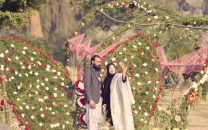Harappa to have a mini cinema auditorium
Museum curator says around Rs25 million have been spent on project

Documentaries will be screened in the auditorium to educate local and foreign tourists about the world’s oldest civilisation. PHOTO: FILE
Harappa Museum curator Muhammad Hasan told The Express Tribune that work on the project started in December 2018 and the cinema will be inaugurated in June 2020. Around Rs25 million are being spent on this project.
“We are working extensively for the archaeological conservation of Harappa ruins and museum since 2007. The four walls were built to secure the site at a cost of Rs6 million to ensure it is accessible from only the main gate,” said Hasan.
Earlier, it was reported that during research, many historical items such as jewellery, statues, clay utensils, stamps, as well as the skeletal remains of a man and a woman, were found. Keeping in view the increasing number of tourists frequently visiting the place, the museum’s hall has been extended. The label and identification marks on the antiques are also upgraded to educate tourists. A long track has been laid out for the travellers to move around the ruins easily. Lush green gardens have also been meticulously manicured to add to the beauty of Harappa. Hasan said a ticket to the Harappa tour costs Rs20 for local and up to Rs500 for tourists.
The ruins, discovered over a sustained period of time, are spread over 130 acres of land. The Harappa excavation began in 1920. Although the reasons behind the end of the civilisation remain a mystery, researchers have varied theories.
Some archaeological experts say foreign invaders caused the downfall of the ancient city, while others believed floods wiped it off the map as it is situated on the banks of the Indus River.
Yet another theory dismisses the above claims, saying an earthquake brought about the end of the civilisation. However, the research teams and historians continue to visit the site to unearth more facts. Famous historian and archaeological expert General Alexander also discussed Harappa in his annual research report. He said authorities had not paid enough attention to the site for a long time. Therefore, locals used the historic bricks in the construction of their houses.
The structures found during excavation suggest that the people from that civilisation not only buried their dead, but also put items of daily use with the body. The city’s map is carved onto the large rectangular tombs. The people of Harappa were mostly farmers and well aware of agricultural techniques.
The Harappa ruins are situated 27 km southwest of Sahiwal and there are different theories on the origins of the city’s name. Some experts suggest that the word Harappa comes from ‘Har’, which means to take away or be swallowed down. When this ancient city was destroyed, the locals began to call it ‘Har’ which later became Harappa.
Published in The Express Tribune, September 24th, 2019.
Have something to add to the story? Share it in the comments below.



















COMMENTS
Comments are moderated and generally will be posted if they are on-topic and not abusive.
For more information, please see our Comments FAQ